Fenestration: Solving Renovation Issues
Manufactured Fenestration Systems
Manufactured products used for wall fenestration in renovation projects typically fall into three categories: curtain wall systems, storefront systems, and unit windows. Curtain wall systems can be large or small, field assembled or factory built, but are designed to hang continuously outside of a building structural system. Storefront systems are intended for a first or second floor installation and fit between floor and ceiling structures. Unit windows are fit into openings in a wall system and are available in a full range of sizes and types. All three types can achieve NFRC certification, but only some unit windows will carry an actual label. Curtain wall, storefront, and some specialized windows use standardized computerized ratings for certification. In all cases, though, each manufactured unit or system will be assessed in terms of total performance based on the traits and characteristics of the individual components that go into them.
Storefront and Curtain Wall Systems
These systems are available in a wide range of fully customizable options and choices suitable for renovation projects of all types. Advances in technology and design in recent times have provided flexible installation, improved energy efficiency, and a very favorable return on investment in most cases. While storefront framing has not always been regarded as high performance in the past, current products are capable of reaching U-factors as low as U-0.31 (R-3.2) with common low-e glass combinations and U-0.28 (R-3.57) with dual-coated units. “Architects of retail and mixed-use projects can benefit greatly from these latest storefront products, as the energy efficiency of the entire building envelope will be enhanced from the street up,” says Josh Wignall, storefront and curtain wall marketing product manager for EFCO. He points out that such systems are thermally broken and can be used in conjunction with standard entrance systems providing enhanced thermal performance and increasing energy-savings potential. Overall, currently available systems provide thermally efficient curtain wall and storefront systems that have the flexibility and cost-effectiveness for use by architects and glaziers on a wide range of projects. Increasingly known for their superior thermal U-factors and architectural-grade structural performance, these products are widely recognized for their ability to manage hot and cold environmental fluctuations without sacrificing structural capabilities.
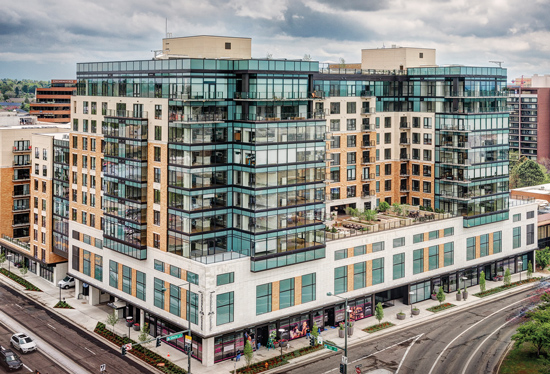
Photo courtesy of Pella EFCO Commercial Solutions
Curtain walls, storefront systems, and unit windows all combine different components to achieve an overall performance rating with many achieving excellent results.
Popular Unit Windows
Many renovation and new projects incorporate standard, premanufactured windows in some popular styles. Double-hung and single-hung windows fabricated in wood or metal have historically been used in many residential and commercial buildings. Manufacturers have found ways to keep the classic look of these windows but meet the increasing performance demands of architects and glaziers to provide energy-saving products with U-factors as low as U-0.26 (R-3.8) with 1-inch low-e coated IGUs. They are also meeting increased needs for economical framing systems that achieve higher strength and durability suitable for use in commercial, government, educational, and multifamily housing projects. Some manufacturers offer a fixed mating frame, which allows for transoms, sidelights, and other custom opening configurations to be readily worked into the design.
Other window types and styles are popular in renovation projects as well, including awning and casement styles that can project inward or project outward. These windows typically offer many design options, allowing for custom designs using standard window products. Glazing can be double or triple paned for improved energy savings, and some offer optional integral window blinds for interior light or privacy control capabilities. If fabricated from aluminum, there are multiple anodized or painted-finish solutions to address economic and aesthetic concerns. All use modern window hardware for enhanced operation and maintenance.
Monumental Windows
In many existing buildings the window openings may be very large, thus being referred to as monumental windows. These are commonly historic buildings, but could be fairly recent too simply with proportioned openings that call for larger than typical window units. Manufacturers have responded to this need as well, providing wood and aluminum-clad wood windows suitably rated for commercial projects. According to Stacy Seelye, Pella product specialist, “The new monumental hung windows are a welcome addition to the available choices in the market.” Architects can now select the full range of sizes from a single manufacturer for virtually any low- to mid-rise commercial project, especially for building retrofits, where historical accuracy and energy efficiency can be equally important. Such windows are available in size range up to 6 feet wide by 12 feet high with optional triple-pane insulated glass for improved thermal performance on the order of a total unit U-factor of 0.28 (R-3.5) in double-glazed units with argon gas and U-0.18 (R-5.5) in triple-glazed units with krypton gas.

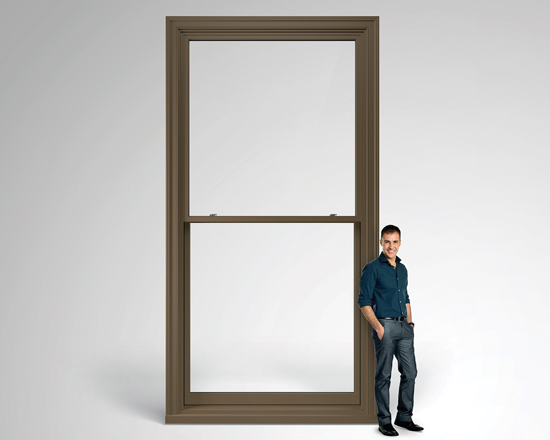
Photos courtesy of Pella EFCO Commercial Solutions
Monumental windows are now available in very large sizes to suit historical conditions and improve energy efficiency.
Tilt and Turn Windows
An innovative and flexible window type, one that can either tilt open or swing open, has been commonly used in Europe for many years and is becoming more popular in the United States. In fact, at least one company with roots in German engineering has established a manufacturing plant here in the United States to respond to the growing demand for these high-performance windows with a unique form of operation. They rely on a combination of engineering design, custom window hardware, and continuous gasketing to operate successfully. An interior handle rotates the hardware in one of three positions. In the locked position, the movable sash is closed firmly against the gasketed frame to seal the window unit tightly against air and weather infiltration. In the first open position, the window sash tilts inward from a hinge engaged at the bottom. This allows a basic amount of ventilation, while still limiting exposure to the elements—in this position, water just rolls off the slanted sash and drains out. By closing and re-opening the window into the second open position, it swings inward like an inward-projecting casement window, allowing for maximum light and natural ventilation.
Beyond the operational aspects of tilt and turn windows, they are also known for the attention to detail to produce a range of beneficial outcomes, including very high thermal performance, enhanced acoustics, ease of use/functionality, security (resistance to forced entry), and interior comfort. Many profiles and configurations are available, including profiles that offer narrow sight-lines such that large areas of glass can be available throughout. While all of this usually translates into additional cost compared to other American windows, the extra investment is generally regarded as small compared to the benefits. Of course, as performance of all windows continues to improve and as manufacturing of tilt and turn products develops further, the price gap between them may well shrink as precision units become more efficiently produced at more competitive prices. In some cases, they are even provided on a factory direct basis to a project, eliminating distributor cost mark-ups.
Another common attribute of tilt and turn windows is the use of sash frames that are wide enough to accommodate triple glazing. This allows glass U-factor values in the range of 0.12 or 0.13 (R-7.69 to R-8.33) with warm edge technology incorporated to optimize energy performance of the total window unit. That means large areas of glass can be used to bring in the benefits of daylighting, while still balancing thermal heat transfer. It also means building occupants experience greater interior comfort from the warmer interior glass surfaces.
Todd F. Bachelder, chief executive officer of Menck Windows, sums up the high performance and innovative operation of tilt and turn windows this way: “Building owners need fenestration products that will last and keep the building more comfortable, while reducing energy consumption, maintenance costs, and carbon emissions. Architects need to be able to select and specify products based upon the latest building technology from manufacturers that stand behind their products and services. Everyone needs windows that help ensure a long-lasting, energy-efficient, sustainable building—one that’s going to appreciate in value over time.”
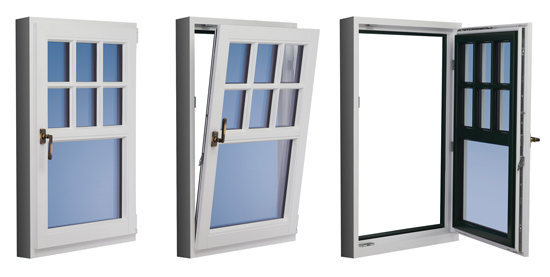
Image courtesy of Menck Windows
Tilt and turn windows allow for an innovative operation as shown in these photos: (left) in the closed and locked position, (middle) in the tilted inward position with the bottom hinges engaged, and (right) in the fully open position with the sash turned inward engaging the side hinges.
Custom Windows
There are cases where building renovations require windows to fit some pre-existing conditions or incorporate custom features to achieve results that match design, function, or historic needs. In those cases, there are manufacturers available who can provide full-service design support and supply high-quality, architectural-grade windows. Of course, these same manufacturers can do this for new construction, too, so architects can call on their experience and support for a full range of building construction projects. Some go beyond unit windows and have a full line of curtain wall, window wall, and storefront options to help ensure a functional system, regardless of the type of fenestration. For this discussion, let’s remain focused on some examples of custom unit windows.
Custom window manufacturers pride themselves in being able to craft windows to meet virtually any need. Dependent on the architectural vision, many times these windows can be an architectural highlight of the overall design, in which case they can be a main building feature. In addition to meeting the aesthetic needs, these custom windows still protect occupants from the elements and allow natural daylight into the building. They can also be specified to provide high thermal performance and can be tested for such. A large percentage of renovation projects require custom shapes that simply may not be available without a custom fabrication. Customization can also include an entire new product, unique panning and trim, or enhancing an existing product to meet specific project performance requirements.
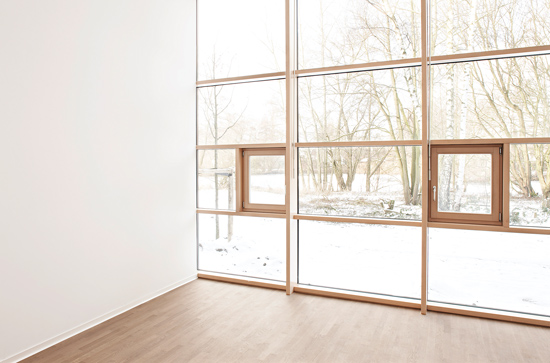
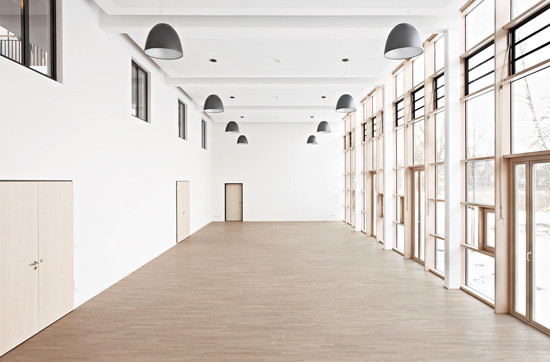
Photos courtesy of Menck Windows
Triple-glazed tilt and turn windows incorporated into a larger timber-based curtain wall system provide high-performance lighting and ventilation.
By way of example, consider a situation where double-hung windows are being replaced or installed, but the sash can be quite heavy to operate. Historically, that meant there were counterweights in the wall hung on pulleys to make the operation easier. A modern, custom alternative, however, is to use self-balanced windows, where both sashes operate simultaneously and counter balance each other. This eliminates the maintenance involved with traditional balance hardware and virtually eliminates sash-weight design issues. It also allows for increased natural ventilation since a greater window area is open at once. Custom systems such as this have been tested and found to meet or exceed industry standards for life-cycle testing.
Conversely, consider a condition where the windows are no longer desired to be operational but the look of a double-hung window still needs to be maintained. In this case, off-set fixed windows can be custom fabricated that simulate a double-hung window but with fixed sashes. This can reduce the overall cost of projects since fixed windows are less costly than operable windows. This approach can also save energy since fixed windows commonly have less air infiltration than operable windows, leading to better thermal performance. Since there are no moving parts or hardware, they also require less maintenance. From a design perspective, this custom approach allows some off-set fixed windows to be used that can seamlessly match adjacent operable hung windows using the same frame depth.
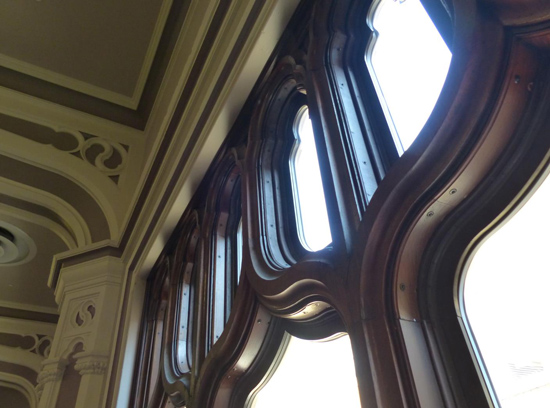
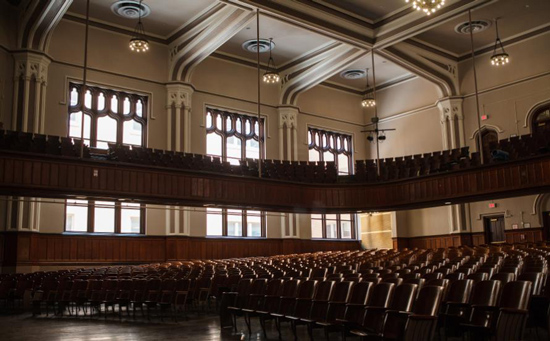
Photos courtesy of Graham Architectural Products
Custom windows made from cast aluminum were fabricated to replace the original wood windows that had deteriorated in this historically significant school auditorium.
Design Support Services
In order to fully account for the impact of windows on building performance, they should be looked at as part of an overall envelope analysis with an emphasis on the contributions offered by glazing types, air sealing, occupant comfort, and improved aesthetics. This is an important step on any project but especially on the renovation of existing buildings, particularly if the building is being converted from some other use (i.e. warehouse, school, etc.) into multifamily housing as has become very popular in many areas.
This analysis can be done in-house by architectural firms using available computer modeling software or by working with window manufacturers who have customized software to analyze the options of different window systems in a given building envelope system. Either way, a baseline building can be modeled and the relative changes can be compared by modeling specific window designs, types, and options.
Some manufacturers offer a whole-building analysis service, which is truly unique from the component approach. According to Doug Phelps, Director of Commercial Business Development at Pella EFCO Commercial Solutions, “Using envelope analysis, we’re able to analyze and run ‘what-if’ scenarios to compare potential envelope improvements in terms of energy savings, occupant comfort, and building aesthetics. Every project has specific goals, and we are able to support the project team with flexible, real-time analysis.” Services are also available to provide a thermal analysis, which helps the design team understand the difference in thermal performance between existing windows and new windows.
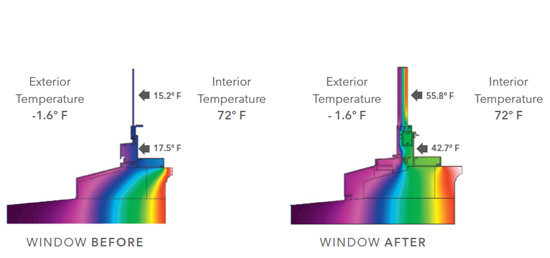
Images courtesy of Pella EFCO Commercial Solutions
The images above show how first-generation single-pane windows (left) would have an interior glazing temperature much closer to the relative exterior air temperature. Additional panes and improved design have greatly reduced the amount of heat transfer, reducing energy use and improving comfort for occupants.
Conclusion
Incorporating new or replacement fenestration into a building renovation can make a dramatic difference on the overall performance, longevity, and appearance of the renovated building. Understanding the performance principles and standards in the design process can yield significant results in the operation of the building. Staying up to date on available products, systems, and other manufactured fenestration choices can provide designers with a broad palette to create significant design statements. Overall, fenestration can be used by architects to create buildings that are better designed, more appealing to users, and more cost effective to operate.
Notice

www.efcocorp.com

www.extechinc.com
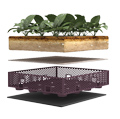
www.firestonebpco.com
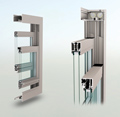
www.grahamwindows.com
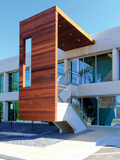
www.guardian.com/commercial
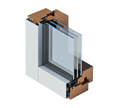
www.menckwindows.com/products/overview/

www.technoform.us









